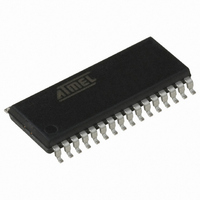AT90PWM3-16SQ Atmel, AT90PWM3-16SQ Datasheet - Page 192

AT90PWM3-16SQ
Manufacturer Part Number
AT90PWM3-16SQ
Description
IC AVR MCU FLASH 8K 32SOIC
Manufacturer
Atmel
Series
AVR® 90PWM Lightingr
Datasheet
1.AT90PWM3B-16SU.pdf
(361 pages)
Specifications of AT90PWM3-16SQ
Core Processor
AVR
Core Size
8-Bit
Speed
16MHz
Connectivity
SPI, UART/USART
Peripherals
Brown-out Detect/Reset, POR, PWM, WDT
Number Of I /o
27
Program Memory Size
8KB (8K x 8)
Program Memory Type
FLASH
Eeprom Size
512 x 8
Ram Size
512 x 8
Voltage - Supply (vcc/vdd)
2.7 V ~ 5.5 V
Data Converters
A/D 11x10b; D/A 1x10b
Oscillator Type
Internal
Operating Temperature
-40°C ~ 105°C
Package / Case
32-SOIC (7.5mm Width)
Processor Series
AT90PWMx
Core
AVR8
Data Bus Width
8 bit
Data Ram Size
512 B
Interface Type
SPI, USART
Maximum Clock Frequency
16 MHz
Number Of Programmable I/os
27
Number Of Timers
2
Operating Supply Voltage
2.7 V to 5.5 V
Maximum Operating Temperature
+ 105 C
Mounting Style
SMD/SMT
3rd Party Development Tools
EWAVR, EWAVR-BL
Development Tools By Supplier
ATAVRDRAGON, ATSTK500, ATSTK600, ATAVRISP2, ATAVRONEKIT, ATAVRFBKIT, ATAVRISP2
Minimum Operating Temperature
- 40 C
On-chip Adc
10 bit, 11 Channel
On-chip Dac
10 bit, 1 Channel
For Use With
ATSTK600-SOIC - STK600 SOCKET/ADAPTER FOR SOICATAVRMC200 - KIT EVAL FOR AT90PWM3 ASYNCATAVRFBKIT - KIT DEMO BALLAST FOR AT90PWM2ATSTK520 - ADAPTER KIT FOR 90PWM
Lead Free Status / RoHS Status
Lead free / RoHS Compliant
- Current page: 192 of 361
- Download datasheet (7Mb)
18.6.4
18.6.5
18.7
18.7.1
192
Data Reception – USART Receiver
AT90PWM2/3/2B/3B
Parity Generator
Disabling the Transmitter
Receiving Frames with 5 to 8 Data Bits
global interrupts are enabled). UDRE is cleared by writing UDR. When interrupt-driven data
transmission is used, the Data Register Empty interrupt routine must either write new data to
UDR in order to clear UDRE or disable the Data Register Empty interrupt, otherwise a new inter-
rupt will occur once the interrupt routine terminates.
The Transmit Complete (TXC) flag bit is set one when the entire frame in the Transmit Shift Reg-
ister has been shifted out and there are no new data currently present in the transmit buffer. The
TXC flag bit is automatically cleared when a transmit complete interrupt is executed, or it can be
cleared by writing a one to its bit location. The TXC flag is useful in half-duplex communication
interfaces (like the RS-485 standard), where a transmitting application must enter receive mode
and free the communication bus immediately after completing the transmission.
When the Transmit Complete Interrupt Enable (TXCIE) bit in UCSRB is set, the USART Trans-
mit Complete Interrupt will be executed when the TXC flag becomes set (provided that global
interrupts are enabled). When the transmit complete interrupt is used, the interrupt handling rou-
tine does not have to clear the TXC flag, this is done automatically when the interrupt is
executed.
The Parity Generator calculates the parity bit for the serial frame data. When parity bit is enabled
(UPM1 = 1), the transmitter control logic inserts the parity bit between the last data bit and the
first stop bit of the frame that is sent.
The disabling of the Transmitter (setting the TXEN to zero) will not become effective until ongo-
ing and pending transmissions are completed, i.e., when the Transmit Shift Register and
Transmit Buffer Register do not contain data to be transmitted. When disabled, the Transmitter
will no longer override the TxD pin.
The USART Receiver is enabled by writing the Receive Enable (RXEN) bit in the UCSRB Regis-
ter to one. When the Receiver is enabled, the normal pin operation of the RxD pin is overridden
by the USART and given the function as the Receiver’s serial input. The baud rate, mode of
operation and frame format must be set up once before any serial reception can be done. If syn-
chronous operation is used, the clock on the XCK pin will be used as transfer clock.
The Receiver starts data reception when it detects a valid start bit. Each bit that follows the start
bit will be sampled at the baud rate or XCK clock, and shifted into the Receive Shift Register until
the first stop bit of a frame is received. A second stop bit will be ignored by the Receiver. When
the first stop bit is received, i.e., a complete serial frame is present in the Receive Shift Register,
the contents of the Shift Register will be moved into the receive buffer. The receive buffer can
then be read by reading the UDR I/O location.
The following code example shows a simple USART receive function based on polling of the
Receive Complete (RXC) flag. When using frames with less than eight bits the most significant
bits of the data read from the UDR will be masked to zero. The USART has to be initialized
before the function can be used.
4317J–AVR–08/10
Related parts for AT90PWM3-16SQ
Image
Part Number
Description
Manufacturer
Datasheet
Request
R

Part Number:
Description:
IC AVR MCU FLASH 8K 32QFN
Manufacturer:
Atmel
Datasheet:

Part Number:
Description:
MCU AVR 8K FLASH 16MHZ 32-QFN
Manufacturer:
Atmel
Datasheet:

Part Number:
Description:
DEV KIT FOR AVR/AVR32
Manufacturer:
Atmel
Datasheet:

Part Number:
Description:
INTERVAL AND WIPE/WASH WIPER CONTROL IC WITH DELAY
Manufacturer:
ATMEL Corporation
Datasheet:

Part Number:
Description:
Low-Voltage Voice-Switched IC for Hands-Free Operation
Manufacturer:
ATMEL Corporation
Datasheet:

Part Number:
Description:
MONOLITHIC INTEGRATED FEATUREPHONE CIRCUIT
Manufacturer:
ATMEL Corporation
Datasheet:

Part Number:
Description:
AM-FM Receiver IC U4255BM-M
Manufacturer:
ATMEL Corporation
Datasheet:

Part Number:
Description:
Monolithic Integrated Feature Phone Circuit
Manufacturer:
ATMEL Corporation
Datasheet:

Part Number:
Description:
Multistandard Video-IF and Quasi Parallel Sound Processing
Manufacturer:
ATMEL Corporation
Datasheet:

Part Number:
Description:
High-performance EE PLD
Manufacturer:
ATMEL Corporation
Datasheet:

Part Number:
Description:
8-bit Flash Microcontroller
Manufacturer:
ATMEL Corporation
Datasheet:

Part Number:
Description:
2-Wire Serial EEPROM
Manufacturer:
ATMEL Corporation
Datasheet:










